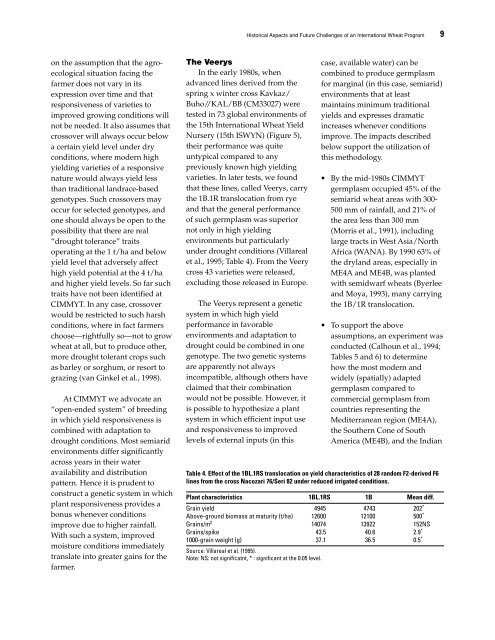Septoria and Stagonospora Diseases of Cereals - CIMMYT ...
Septoria and Stagonospora Diseases of Cereals - CIMMYT ...
Septoria and Stagonospora Diseases of Cereals - CIMMYT ...
Create successful ePaper yourself
Turn your PDF publications into a flip-book with our unique Google optimized e-Paper software.
on the assumption that the agroecological<br />
situation facing the<br />
farmer does not vary in its<br />
expression over time <strong>and</strong> that<br />
responsiveness <strong>of</strong> varieties to<br />
improved growing conditions will<br />
not be needed. It also assumes that<br />
crossover will always occur below<br />
a certain yield level under dry<br />
conditions, where modern high<br />
yielding varieties <strong>of</strong> a responsive<br />
nature would always yield less<br />
than traditional l<strong>and</strong>race-based<br />
genotypes. Such crossovers may<br />
occur for selected genotypes, <strong>and</strong><br />
one should always be open to the<br />
possibility that there are real<br />
“drought tolerance” traits<br />
operating at the 1 t/ha <strong>and</strong> below<br />
yield level that adversely affect<br />
high yield potential at the 4 t/ha<br />
<strong>and</strong> higher yield levels. So far such<br />
traits have not been identified at<br />
<strong>CIMMYT</strong>. In any case, crossover<br />
would be restricted to such harsh<br />
conditions, where in fact farmers<br />
choose—rightfully so—not to grow<br />
wheat at all, but to produce other,<br />
more drought tolerant crops such<br />
as barley or sorghum, or resort to<br />
grazing (van Ginkel et al., 1998).<br />
At <strong>CIMMYT</strong> we advocate an<br />
“open-ended system” <strong>of</strong> breeding<br />
in which yield responsiveness is<br />
combined with adaptation to<br />
drought conditions. Most semiarid<br />
environments differ significantly<br />
across years in their water<br />
availability <strong>and</strong> distribution<br />
pattern. Hence it is prudent to<br />
construct a genetic system in which<br />
plant responsiveness provides a<br />
bonus whenever conditions<br />
improve due to higher rainfall.<br />
With such a system, improved<br />
moisture conditions immediately<br />
translate into greater gains for the<br />
farmer.<br />
Historical Aspects <strong>and</strong> Future Challenges <strong>of</strong> an International Wheat Program 9<br />
The Veerys<br />
In the early 1980s, when<br />
advanced lines derived from the<br />
spring x winter cross Kavkaz/<br />
Buho//KAL/BB (CM33027) were<br />
tested in 73 global environments <strong>of</strong><br />
the 15th International Wheat Yield<br />
Nursery (15th ISWYN) (Figure 5),<br />
their performance was quite<br />
untypical compared to any<br />
previously known high yielding<br />
varieties. In later tests, we found<br />
that these lines, called Veerys, carry<br />
the 1B.1R translocation from rye<br />
<strong>and</strong> that the general performance<br />
<strong>of</strong> such germplasm was superior<br />
not only in high yielding<br />
environments but particularly<br />
under drought conditions (Villareal<br />
et al., 1995; Table 4). From the Veery<br />
cross 43 varieties were released,<br />
excluding those released in Europe.<br />
The Veerys represent a genetic<br />
system in which high yield<br />
performance in favorable<br />
environments <strong>and</strong> adaptation to<br />
drought could be combined in one<br />
genotype. The two genetic systems<br />
are apparently not always<br />
incompatible, although others have<br />
claimed that their combination<br />
would not be possible. However, it<br />
is possible to hypothesize a plant<br />
system in which efficient input use<br />
<strong>and</strong> responsiveness to improved<br />
levels <strong>of</strong> external inputs (in this<br />
case, available water) can be<br />
combined to produce germplasm<br />
for marginal (in this case, semiarid)<br />
environments that at least<br />
maintains minimum traditional<br />
yields <strong>and</strong> expresses dramatic<br />
increases whenever conditions<br />
improve. The impacts described<br />
below support the utilization <strong>of</strong><br />
this methodology.<br />
• By the mid-1980s <strong>CIMMYT</strong><br />
germplasm occupied 45% <strong>of</strong> the<br />
semiarid wheat areas with 300-<br />
500 mm <strong>of</strong> rainfall, <strong>and</strong> 21% <strong>of</strong><br />
the area less than 300 mm<br />
(Morris et al., 1991), including<br />
large tracts in West Asia/North<br />
Africa (WANA). By 1990 63% <strong>of</strong><br />
the dryl<strong>and</strong> areas, especially in<br />
ME4A <strong>and</strong> ME4B, was planted<br />
with semidwarf wheats (Byerlee<br />
<strong>and</strong> Moya, 1993), many carrying<br />
the 1B/1R translocation.<br />
• To support the above<br />
assumptions, an experiment was<br />
conducted (Calhoun et al., 1994;<br />
Tables 5 <strong>and</strong> 6) to determine<br />
how the most modern <strong>and</strong><br />
widely (spatially) adapted<br />
germplasm compared to<br />
commercial germplasm from<br />
countries representing the<br />
Mediterranean region (ME4A),<br />
the Southern Cone <strong>of</strong> South<br />
America (ME4B), <strong>and</strong> the Indian<br />
Table 4. Effect <strong>of</strong> the 1BL.1RS translocation on yield characteristics <strong>of</strong> 28 r<strong>and</strong>om F2-derived F6<br />
lines from the cross Nacozari 76/Seri 82 under reduced irrigated conditions.<br />
Plant characteristics 1BL.1RS 1B Mean diff.<br />
Grain yield 4945 4743 202 *<br />
Above-ground biomass at maturity (t/ha) 12600 12100 500 *<br />
Grains/m2 14074 13922 152NS<br />
Grains/spike 43.5 40.6 2.9 *<br />
1000-grain weight (g) 37.1 36.5 0.5 *<br />
Source: Villareal et al. (1995).<br />
Note: NS: not significatnt, * : significant at the 0.05 level.









